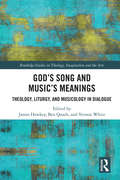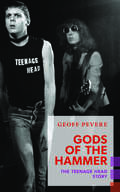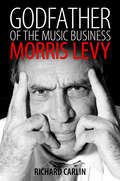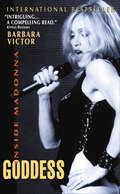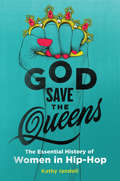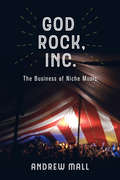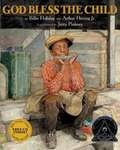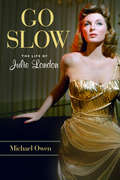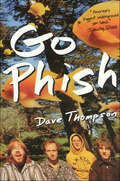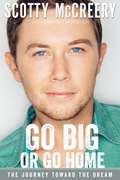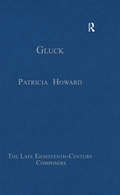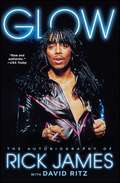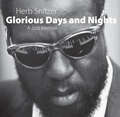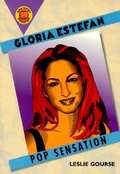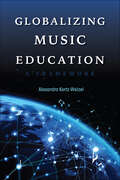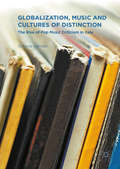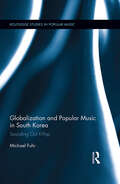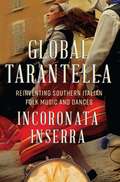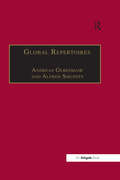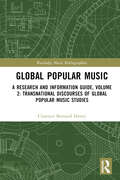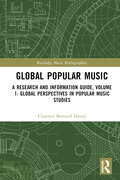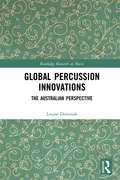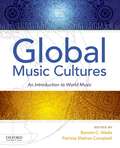- Table View
- List View
God’s Song and Music’s Meanings: Theology, Liturgy, and Musicology in Dialogue (Routledge Studies in Theology, Imagination and the Arts)
by Vernon White James Hawkey Ben QuashTaking seriously the practice and not just the theory of music, this ground-breaking collection of essays establishes a new standard for the interdisciplinary conversation between theology, musicology, and liturgical studies. The public making of music in our society happens more often in the context of chapels, churches, and cathedrals than anywhere else. The command to sing and make music to God makes music an essential part of the DNA of Christian worship. The book’s three main parts address questions about the history, the performative contexts, and the nature of music. Its opening four chapters traces how accounts of music and its relation to God, the cosmos, and the human person have changed dramatically through Western history, from the patristic period through medieval, Reformation and modern times. A second section examines the role of music in worship, and asks what—if anything—makes a piece of music suitable for religious use. The final part of the book shows how the serious discussion of music opens onto considerations of time, tradition, ontology, anthropology, providence, and the nature of God. A pioneering set of explorations by a distinguished group of international scholars, this book will be of interest to anyone interested in Christianity’s long relationship with music, including those working in the fields of theology, musicology, and liturgical studies.
Gods of the Hammer: The Teenage Head Story (Exploded Views)
by Geoff Pevere'Teenage Head changed the face of music in this country. I would not be who I am today without their first record ... In 1979 they were the only band that mattered.' - Hugh Dillon In the late 1970s and early 1980s, no Canadian band rocked harder, louder or to more hardcore fans than Hamilton, Ontario's own Teenage Head. Although usually lumped in the dubiously inevitable 'punk rock' category of the day, this high--energy quartet --consisting of four guys who'd known each other since high school --were really only punk by association. In essence they were a full--on, balls--to--the--wall, three--chord, kick--out--the--jams band that obliterated categories and labels with the sheer force of their sonic assault, and everywhere they played they converted the merely curious to the insanely devoted. And they almost became world famous. Almost. This is their story, told in full and for the first time, and by those who lived to tell the tale. Praise for Gods of the Hammer: 'A riot of a good read on Teenage Head ... the writing is fast-paced and lively, told from the laudatory perspective of a frustrated fan trying to explain why such a great band never got its due.' - The Hamilton Spectator 'I loved it! Wanted it to last forever! Geoff Pevere has done an ace portrait of all that is great and dirty in rock and roll.' - Bruce McDonald 'Pevere's is an on-the-ground fan's account of how the band enamoured a country and how if just that one last, special piece fell into place -- if they were managed better, if an American record deal came sooner, if guitarist Gord Lewis hadn't been laid up for half a year at their very peak by a back-breaking car accident -- songs like "Picture My Face" and "Let's Shake" would be played before face-offs and stocked in jukeboxes from St. John's to San Francisco. The Head were always just a centimetre away from super-stardom. To a generation of hip music fans, they're as classic as The Cars, but instead of ubiquity, their story is a distinctly Canadian Almost Famous.' - Chart Attack Praise for Geoff Pevere: 'After almost 30 years of writing about the movies, Geoff Pevere's anti-establishment views are just as strong as ever, but now he wears them as comfortably as an old leather jacket. He has always been more interested in broadening people's interests than in trying to narrow them. In an age with almost unlimited access to film, just one stream in an onrushing tide of media, this is daring. For the boy who once had to wait months to see Citizen Kane, however, it's simply a gesture of generosity.' -- Toronto Screen Shot
Godfather of the Music Business: Morris Levy (American Made Music Series)
by Richard CarlinAssociation of Recorded Sound Collections Awards for ExcellenceBest Historical Research in Record Labels – Best History (2017)This biography tells the story of one of the most notorious figures in the history of popular music, Morris Levy (1927-1990). At age nineteen, he cofounded the nightclub Birdland in Hell's Kitchen, which became the home for a new musical style, bebop. Levy operated one of the first integrated clubs on Broadway and helped build the careers of Dizzy Gillespie and Bud Powell and most notably aided the reemergence of Count Basie. In 1957, he founded a record label, Roulette Records. Roulette featured many of the significant jazz artists who played Birdland but also scored top pop hits with acts like Buddy Knox, Frankie Lymon and the Teenagers, Joey Dee and the Starliters, and, in the mid-1960s, Tommy James.Stories abound of Levy threatening artists, songwriters, and producers, sometimes just for the sport, other times so he could continue to build his empire. Along the way, Levy attracted "investors" with ties to the Mafia, including Dominic Ciaffone (a.k.a. "Swats" Mulligan), Tommy Eboli, and the most notorious of them all, Vincent Gigante. Gigante allegedly owned large pieces of Levy's recording and retail businesses.Starting in the late 1950s, the FBI and IRS investigated Levy but could not make anything stick until the early 1980s, when Levy foolishly got involved in a deal to sell remaindered records to a small-time reseller, John LaMonte. With partners in the mob, Levy tried to force LaMonte to pay for four million remaindered records. When the FBI secretly wiretapped LaMonte in an unrelated investigation and agents learned about the deal, investigators successfully prosecuted Levy in the extortion scheme. Convicted in 1988, Levy did not live to serve prison time. Stricken with cancer, he died just as his last appeals were exhausted. However, even if he had lived, Levy's brand of storied high life was effectively bust. Corporate ownership of record labels doomed most independents in the business, ending the days when a savvy if ruthless hustler could blaze a path to the top.
Goddess: Inside Madonna
by Barbara VictorGoddess is the book that Madonna and her entourage did not want published. Long before the star could instruct her family and friends not to talk to the author, Barbara Victor spent more than eighteen months in Michigan, the United Kingdom, France, Italy, California, New York, and Florida, interviewing Madonna's father and stepmother, her grandmother and other family members, as well as friends, neighbors, business associates, and former lovers and colleagues, some of whom knew the Ciccone family from the time Madonna was a young child, many of whom have never before spoken either on or off the record.In this extraordinary biography, Barbara Victor taps into previously unexplored sources to unmask the privet person behind the public image. As a result of her extensive research, Victor casts new light on every aspect of Madonna's career and private life -- from her childhood in Michigan to her early years in New York, from meteoric ascent to stardom to her most recent incarnation as an English wife and mother.After almost two decades, since she first appeared in the international music scene, Madonna continues to fascinate and challenge both her fans and her detractors. With her remarkable ability to reinvent herself -- from diva to provocateur, from artist to mogul -- she continues to command more attention and arouse more controversy than any other public figure of our time. Alternately criticized and revered, Madonna consistently and dramatically sets style, social, sexual, and musical trends and yet she remains an enigma to her public, keeping her most intimate identity hidden from all but her closest friends.Goddess offers explosive new revelations about Madonna's life, her career, and the fact or fantasy of her lesbian and heterosexual relationships. Barbara Victor has written the definitive biography about a woman who gives new meaning to the term superstar.
God Save the Queens: The Essential History of Women in Hip-Hop
by Kathy IandoliJournalist Kathy Iandoli’sGod Save the Queens is the “rigorous, insightful, and authoritative . . . [and] deadly personal”* history of women in hip-hop.An *NPR Best Book of the YearEvery history of hip-hop focuses primarily on men, glaringly omitting a thorough and respectful examination of the presence and contribution of the genre’s female artists. For far too long, women in hip-hop have been relegated to the shadows, viewed as the designated “First Lady” thrown a contract, a pawn in some beef, or even worse. But as Kathy Iandoli makes clear, the reality is very different. Today, hip-hop is dominated by successful women such as Cardi B and Nicki Minaj, yet there are scores of female artists whose influence continues to resonate.God Save the Queens pays tribute to the women of hip-hop—from the early work of Roxanne Shante, to hitmakers like Queen Latifah and Missy Elliot, to the superstars of today. Exploring issues of gender, money, sexuality, violence, body image, feuds, objectification and more, this is an important and monumental work of music journalism that at last gives these influential female artists the respect they have long deserved.“Music lovers will celebrate this much-needed exploration of the overlooked experiences of women in hip-hop.” —Publishers Weekly“Intended to be a narrative homage to women in hip-hop, this latest work by Iandoli is that and more. . . . [She] gives female artists the recognition they deserve, while showing that there is still work to do.” —Library Journal
God Rock, Inc.: The Business of Niche Music
by Andrew MallPopular music in the twenty-first century is increasingly divided into niche markets. How do fans, musicians, and music industry executives define their markets’ boundaries? What happens when musicians cross those boundaries? What can Christian music teach us about commercial popular music? In God Rock, Inc., Andrew Mall considers the aesthetic, commercial, ethical, and social boundaries of Christian popular music, from the late 1960s, when it emerged, through the 2010s. Drawing on ethnographic research, historical archives, interviews with music industry executives, and critical analyses of recordings, concerts, and music festival performances, Mall explores the tensions that have shaped this evolving market and frames broader questions about commerce, ethics, resistance, and crossover in music that defines itself as outside the mainstream.
God Bless the Child
by Arthur Herzog Jerry Pinkney Billie HolidayFirst performed by jazz legend Billie Holiday in 1939, "God Bless the Child" remains one of her enduring masterpieces. In this interpretation, Pinkney depicts a family moving from the South during the Great Migration.
God Bless America: The Story of an Immigrant Named Irving Berlin (Hyperion Picture Book (eBook))
by Adah NuchiAn inspiring portrait of an immigrant and the gift he gave his new home.Persecuted as Jews, Izzy Baline and his family emigrated from Russia to New York, where he fell in love with his new country. He heard music everywhere and was full to bursting with his own. Izzy's thump-two-three, ting-a-ling, whee tunes soon brought him acclaim as the sought-after songwriter Irving Berlin. He ignited the imaginations of fellow countrymen and women with his Broadway and Hollywood numbers, crafting tunes that have become classics we still sing today.But when darker times came and the nation went to war, it was time for Irving to compose a new kind of song:A boom-rah-rah song.A big brass belter.A loud heart-melter.A song for America.And so "God Bless America" was born, the heart swelling standard that Americans have returned to again and again after its 1918 composition.This is the tale of how a former refugee gave America one of its most celebrated patriotic songs. With stirring, rhythmic text by Adah Nuchi and delightful, energetic art by Rob Polivka, readers will be ready to hum along to this exuberant picturebook.
Go Slow: The Life of Julie London
by Michael OwenIt has been said that the records of singer and actress Julie London were purchased for their provocative, full-color cover photographs as frequently as they were for the music contained in their grooves. During the 1950s and '60s, her piercing blue eyes, strawberry blonde hair, and shapely figure were used to sell the world an image of cool sexuality.The contrast between image and reality, the public and the private, is at the heart of Julie London's story. Through years of research; extensive interviews with family, friends, and musical associates; and access to rarely seen or heard archival material, author Michael Owen reveals the impact of her image on the direction of her career and how it influenced the choices she made, including the ultimate decision to walk away from performing.Go Slow follows Julie London's life and career through its many stages: her transformation from 1940s movie starlet to coolly defiant singer of the classic torch ballad "Cry Me a River" of the '50s, and her journey from Las Vegas hotel entertainer during the rock 'n' roll revolution of the '60s to the no-nonsense nurse of the '70s hit television series Emergency!
Go Phish
by Dave ThompsonOn Halloween night 1983, at an ROTC dance on a college campus deep in the heart of Vermont, the band subsequently known as Phish played their very first gig.It was a total disaster.But it was the beginning of an era. Here's the whole story.
Go Big or Go Home: The Journey Toward the Dream
by Travis Thrasher Scotty MccreeryIt was just a simple singing competition that would be fun to audition for. Who knew what kind of doors it might open for a sixteen-year-old from Garner, North Carolina. Go Big or Go Home is the story of a kid with country songs in his soul. The special thing with Scotty McCreery, however, is that he has this God-given ability to sing those tunes the exact way they should be sung. Daring to enter the limelight at such a young age, Scotty finds himself embraced by the nation, and even overseas, as he competes on "American Idol". This is his journey from his North Carolina roots to winning America’s most popular singing competition and launching a musical career he had always dreamt about. Go Big or Go Home narrates Scotty's journey from a kid imitating Elvis on the school bus to 30 million across America tuning in to see him win Season 10 of "American Idol”. Now as he completes his ground-breaking fourth album, Scotty shares a glimpse of where he came from and the impact his faith, family and friends have had on a humbled guy who keeps asking “why me?”
Gluck: An Eighteenth-century Portrait In Letters And Documents (The\late Eighteenth-century Composers Ser.)
by Patricia HowardThis volume presents a collection of essays by leading Gluck scholars which highlight the best of recent and classic contributions to Gluck scholarship, many of which are now difficult to access. Tracing Gluck�s life, career and legacy, the essays offer a variety of approaches to the major issues and controversies surrounding the composer and his works and range from the degree to which reform elements are apparent in his early operas to his contribution to changing perceptions of Hellenism. The introduction identifies the major topics investigated and highlights the innovatory nature of many of the approaches, particularly those which address perceptions of the composer in the nineteenth and twentieth centuries. This volume, which focuses on one of the most fascinating and influential composers of his era, provides an indispensable resource for academics, scholars and libraries.
Glow
by David Ritz Rick JamesBest known for his song "Super Freak," hitmaker, singer, innovator, producer, award-winning pioneer in the fusion of funk groove and rock, the late Rick James collaborated with music biographer David Ritz in this posthumously published, wildly entertaining, and profound expression of a rock star's life and soul.He was the nephew of Temptations singer Melvin Franklin; a boy who watched and listened, mesmerized from underneath cocktail tables at the shows of Etta James and Miles Davis. He was a vagrant hippie who wandered to Toronto, where he ended up playing with Neil Young and Joni Mitchell, and he became a household name in the 1980s with his hit song "Super Freak." Later in life, he was a bad boy who got caught up in drug smuggling and ended up in prison. But since his passing in August 2004, Rick James has remained a legendary icon whose name is nearly synonymous with funk music--and who popularized the genre, creating a lasting influence on pop artists from Prince to Jay-Z to Snoop Dogg, among countless others. In Glow, Rick James and acclaimed music biographer David Ritz collaborated to write a no-holds-barred memoir about the boy and the man who became a music superstar in America's disco age. It tells of James's upbringing and how his mother introduced him to musical geniuses of the time. And it reveals details on many universally revered artists, from Marvin Gaye and Prince to Nash, Teena Marie, and Berry Gordy. James himself said, "My journey has taken me through hell and back. It's all in my music--the parties, the pain, the oversized ego, the insane obsessions." But despite his bad boy behavior, James was a tremendous talent and a unique, unforgettable human being. His "glow" was an overriding quality that one of his mentors saw in him--and one that will stay with this legendary figure who left an indelible mark on American popular music.
Glorious Days and Nights: A Jazz Memoir
by Herb SnitzerGlorious Days and Nights is a personal account of the fifty-year career of jazz photographer Herb Snitzer, with a special focus on his years in New York City from 1957 to 1964. A photojournalist for Life, Look, and Fortune, Snitzer was the photo editor and later associate editor of the influential jazz magazine Metronome. During the 1960s, politics, race, and social strife and unrest swirled in Snitzer's life as a working artist. But throughout the bus boycotts, demonstrations, civil and racial unrest, what remained constant for him was jazz. Snitzer recalls what it was like to go on the road with these musicians. His reflections run the gamut from serious meditations on his development as a young photographer working with musicians already of great stature to more conversational recollections of casual moments spent having fun with the jazz artists many of whom became close friends. This book includes Snitzer's very best jazz photographs. He reveals the essences of the artists, their struggles, joys, and pains. A number of Snitzer's jazz images have become iconic, including Louis Armstrong with the Star of David, Lester Young at The Five Spot Café in New York City, John Coltrane reflected in a mirror, Thelonious Monk with piano keys reflected in his sunglasses, and Miles Davis at Newport. With eighty-five black-and-white images of jazz giants, Glorious Days and Nights provides a long-awaited testimony to the friendships and artistry that Snitzer developed over his remarkable career.
Gloria Estefan: Pop Sensation
by Leslie GoursePresents a biography of the Cuban-born singer and composer.
Globalizing Music Education: A Framework (Counterpoints: Music and Education)
by Alexandra Kertz-WelzelHow do globalization and internationalization impact music education around the world? By acknowledging different cultural values and priorities, Alexandra Kertz-Welzel's vision challenges the current state of international music education and higher education, which has been dominated by English-language scholarship. Her framework utilizes an interdisciplinary approach and emphasizes the need for developing a pluralistic mode of thinking, while underlining shared foundations and goals. She explores issues of educational transfer, differences in academic discourses worldwide, and the concept of the global mindset to help facilitate much-needed transformations in global music education. This thinking and research, she argues, provides a means for better understanding global transfers of knowledge and ways to avoid culturally and linguistically hegemonic standards. Globalizing Music Education: A Framework is a timely call to action for a more conscious internationalization of music education in which everyone can play a part.
Globalization, Music and Cultures of Distinction
by Simone VarrialeThis book is the first comprehensiveaccount of how Anglo-American popular music transformed Italian cultural life. Drawing on neglected archival materials, the author explores the rise of newmusical tastes and social divisions in late twentieth century Italy. The book reconstructs the emergence of popmusic magazines in Italy and offers the first in-depth investigation of therole of critics in global music cultures. It explores how class, gender, raceand geographical location shaped the production and consumption of music magazines,as well as critics' struggle over notions of expertise, cultural value andcosmopolitanism. Globalization, Music and Cultures ofDistinction provides an innovative framework for studying how globalization transforms cultural institutions andaesthetic hierarchies, thus breaking new ground for sociological and historicalresearch. It will be essential reading for scholars and students interested incultural sociology, popular music, globalization, media and cultural studies,social theory and contemporary Italy.
Globalization and Popular Music in South Korea: Sounding Out K-Pop (Routledge Studies in Popular Music)
by Michael FuhrThis book offers an in-depth study of the globalization of contemporary South Korean idol pop music, or K-Pop, visiting K-Pop and its multiple intersections with political, economic, and cultural formations and transformations. It provides detailed insights into the transformative process in and around the field of Korean pop music since the 1990s, which paved the way for the recent international rise of K-Pop and the Korean Wave. Fuhr examines the conditions and effects of transnational flows, asymmetrical power relations, and the role of the imaginary "other" in K-Pop production and consumption, relating them to the specific aesthetic dimensions and material conditions of K-Pop stars, songs, and videos. Further, the book reveals how K-Pop is deployed for strategies of national identity construction in connection with Korean cultural politics, with transnational music production circuits, and with the transnational mobility of immigrant pop idols. The volume argues that K-Pop is a highly productive cultural arena in which South Korea’s globalizing and nationalizing forces and imaginations coincide, intermingle, and counteract with each other and in which the tension between both of these poles is played out musically, visually, and discursively. This book examines a vibrant example of contemporary popular music from the non-Anglophone world and provides deeper insight into the structure of popular music and the dynamics of cultural globalization through a combined set of ethnographic, musicological, and cultural analysis. Widening the regional scope of Western-dominated popular music studies and enhancing new areas of ethnomusicology, anthropology, and cultural studies, this book will also be of interest to those studying East Asian popular culture, music globalization, and popular music.
Global Tarantella: Reinventing Southern Italian Folk Music and Dances
by Incoronata InserraTarantella, a genre of Southern Italian folk music and dance, is an international phenomenon--seen and heard in popular festivals, performed across the Italian diaspora, even adapted for New Age spiritual practices. The boom in popularity has diversified tarantella in practice while setting it within a host of new, unexpected contexts. Incoronata Inserra ventures into the history, global circulation, and recontextualization of this fascinating genre. Examining tarantella's changing image and role among Italians and Italian Americans, Inserra illuminates how factors like tourism, translation, and world music venues have shifted the ethics of place embedded in the tarantella cultural tradition. Once rural, religious, and rooted, tarantella now thrives in settings urban, secular, migrant, and ethnic. Inserra reveals how the genre's changing dynamics contribute to reimagining Southern Italian identity. At the same time, they translate tarantella into a different kind of performance that serves new social and cultural groups and purposes. Indeed, as Inserra shows, tarantella's global growth promotes a reassessment of gender relations in the Italian South and helps create space for Italian and Italian-American women to reclaim gendered aspects of the genre.
Global Repertoires: Popular Music Within and Beyond the Transnational Music Industry
by Andreas GebesmairWith just four record companies controlling nearly 80 per cent of the world market in popular music, issues of globalization are evidently significant to our understanding of how and why popular music is made and distributed. As transnational industries seek to open up increasingly larger markets, the question of how local and regional music cultures can be sustained is a pressing one. To what extent does the global music market offer opportunities for the worldwide dissemination of local music within and beyond the major industry? The essays in this volume examine the structure and strategies of the transnational music industry, with its deployment of mass communication technologies including sound carriers, satellite broadcasting and the Internet. The book also explores local and individual experience of global music and this music's dissemination through migration and communities of interest, as well as the ideological and political use of different kinds of music. In contrast to recent arguments which posit an American imperialist dominance of popular music, the contributors to this volume find that the global repertoire of the major labels no longer represents the culture of a certain country but is fed by different sources. The essays here discuss how we can characterize this vast de-centered industry, and offer perspectives on the so-called 'international repertoire' that calls for a melodic structure, ballad forms, unaccented vocalisation and an image that has global recognition.
Global Popular Music: A Research and Information Guide, Volume 2: Transnational Discourses of Global Popular Music Studies (Routledge Music Bibliographies)
by Clarence Bernard HenryGlobal Popular Music: A Research and Information Guide offers an essential annotated bibliography of scholarship on popular music around the world in a two-volume set. Featuring a broad range of subjects, people, cultures, and geographic areas, and spanning musical genres such as traditional, folk, jazz, rock, reggae, samba, rai, punk, hip-hop, and many more, this guide highlights different approaches and discussions within global popular music research. This research guide is comprehensive in scope, providing a vital resource for scholars and students approaching the vast amount of publications on popular music studies and popular music traditions around the world. Thorough cross-referencing and robust indexes of genres, places, names, and subjects make the guide easy to use.Volume 2, Transnational Discourses of Global Popular Music Studies, covers the geographical areas of North America: United States and Canada; Central America, Caribbean, and South America/Latin America; Europe; Africa and Middle East; Asia; and areas of Oceania: Aotearoa/New Zealand, Australia, and Pacific Islands. It provides over twenty-four hundred annotated bibliographic entries covering discourses of extensive research that extend beyond the borders of the United States and includes annotated entries to books, book series, book chapters, edited volumes, special documentaries and programming, scholarly journal essays, and other resources that focus on the creative and artistic flows of global popular music.
Global Popular Music: A Research and Information Guide, Volume 1: Global Perspectives in Popular Music Studies (Routledge Music Bibliographies)
by Clarence Bernard HenryGlobal Popular Music: A Research and Information Guide offers an essential annotated bibliography of scholarship on popular music around the world in a two-volume set. Featuring a broad range of subjects, people, cultures, and geographic areas, and spanning musical genres such as traditional, folk, jazz, rock, reggae, samba, rai, punk, hip-hop, and many more, this guide highlights different approaches and discussions within global popular music research. This research guide is comprehensive in scope, providing a vital resource for scholars and students approaching the vast amount of publications on popular music studies and popular music traditions around the world. Thorough cross-referencing and robust indexes of genres, places, names, and subjects make the guide easy to use.Volume 1, Global Perspectives in Popular Music Studies, situates popular music studies within global perspectives and geocultural settings at large. It offers over nine hundred in-depth annotated bibliographic entries of interdisciplinary research and several topical categories that include analytical, critical, and historical studies; theory, methodology, and musicianship studies; annotations of in-depth special issues published in scholarly journals on different topics, issues, trends, and music genres in popular music studies that relate to the contributions of numerous musicians, artists, bands, and music groups; and annotations of selected reference works.
Global Percussion Innovations: The Australian Perspective (Routledge Research in Music)
by Louise DevenishFirst emerging in North America and Europe in the late 1920s, contemporary percussion practices have transitioned from the fringes of contemporary music to the forefront over the past 90 years. In the 1960s contemporary percussion practices reached Australian shores and a new generation of artists added their voices to this narrative. The role of Australian activity is not yet embedded in the wider narrative of international contemporary percussion, nor is the significance of developments in contemporary percussion practices fully realised in the context of Australian music history. In this monograph, political, social and cultural influences on this art form will be examined for the first time in a historical survey of contemporary percussion music in Australia over a 50-year period, from 1960 to 2010. The rise of the percussion ensemble in the twentieth century to a standard chamber music ensemble is now recognised as one of the major advances in western art music practice internationally. A focus will be placed on ensemble activity via definitive documentation and analysis of ensembles that are amongst the most pioneering and longest established of Australian contemporary music organisations, including the Australian Percussion Ensemble, Synergy Percussion, Adelaide Percussions, Nova Ensemble, Tetrafide Percussion, Taikoz, Clocked Out and Speak Percussion amongst others. Closing with a discussion of influences and identity, this historical narrative will expand our understanding of the impact of Australian contributions to the international contemporary music scene while simultaneously examining how developments in contemporary percussion have contributed to Australia’s cultural identity.
Global Music Cultures: An Introduction to World Music
by Patricia Shehan Campbell Bonnie C. WadeIdeal for introductory courses in world music and ethnomusicology, Global Music Cultures gives students an overview of key musical cultures of the world while also incorporating the latest theoretical approaches to the study of world music.
